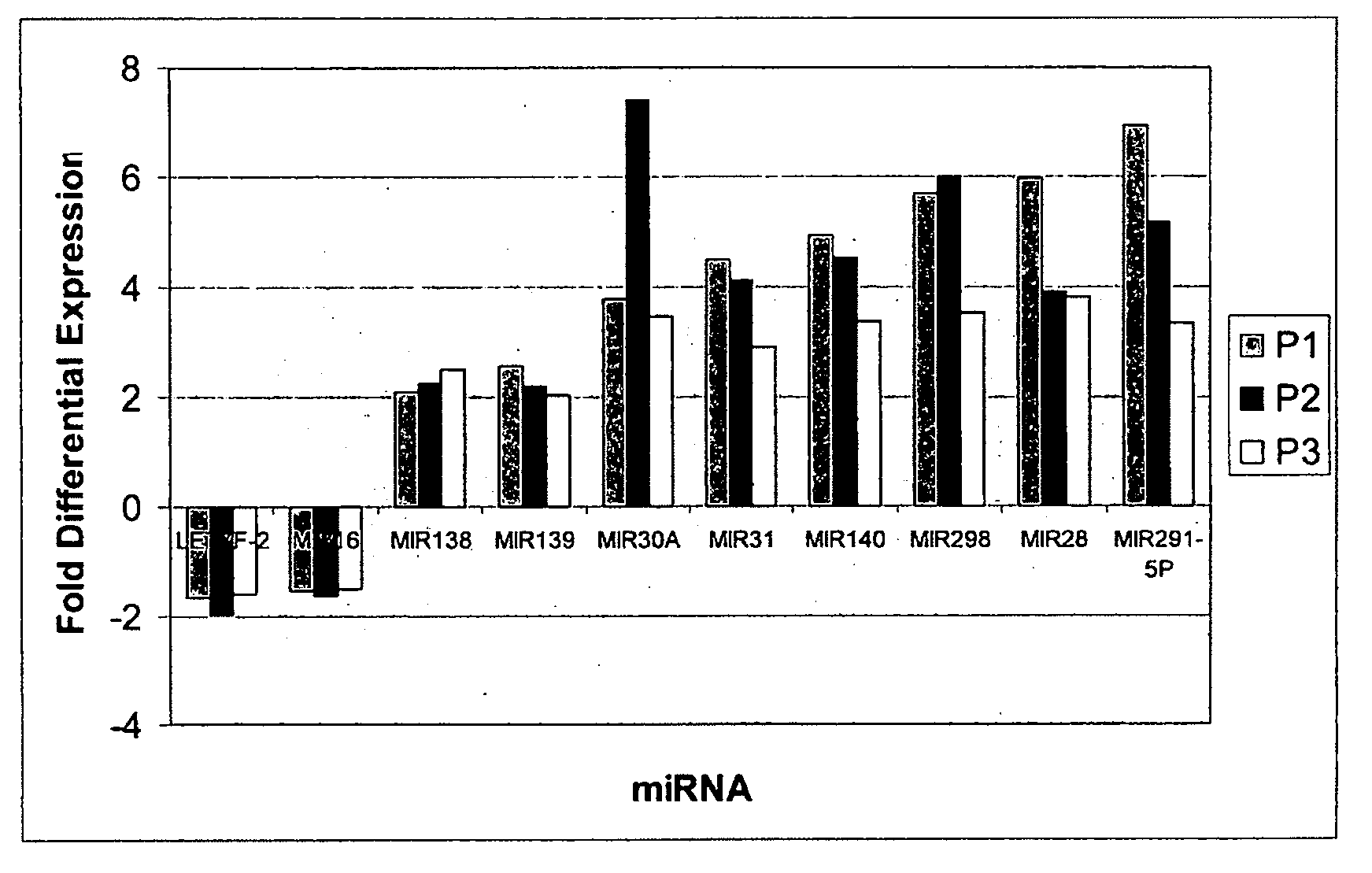Methods and compositions involving mirna and mirna inhibitor molecules
a technology of inhibitor molecules and compositions, applied in the field of molecular biology, can solve the problem of low transfection efficiency of plasmids
- Summary
- Abstract
- Description
- Claims
- Application Information
AI Technical Summary
Problems solved by technology
Method used
Image
Examples
example 1
Assay for Measuring Activity of Precursor miRNAs (Reporter)
[0346]A series of luciferase reporter vectors was created to measure the activities of synthetic miRNAs in cells. The reporter vectors were based on plasmids that had been used to monitor the activity of endogenous miRNAs (Tuschl paper). Briefly, a mammalian expression vector with the luciferase gene under the control of the CMV early promoter was created. Down-stream of the luciferase coding sequence, in the 3′ UTR of the gene, sequences complementary to mature miR-1-2, miR-10, miR-124, miR-19a, and miR-130 were added. The reporter vectors were co-transfected into HeLa cells along with synthetic miRNAs designed to introduce one of the five miRNAs listed above. The transfections involved mixing 200 ng of reporter vector with 0.3, 1, and 3 pmoles of each corresponding synthetic miRNA. The reporter / miRNA mixture was mixed with 0.3 μl of Lipofectamine 2000 (Invitrogen) and incubated for 5-15 minutes. Approximately 8,000 cells w...
example 2
Assay for Measuring Activity of Precursor miRNAs (Endogenous Gene)
[0348]While the luciferase reporter constructs were extremely valuable in evaluating the synthetic miRNA designs, it was important to verify the findings of the reporter constructs by measuring the effects of the synthetic miRNAs on endogenous gene targets. For these studies, the expression of RAS and MYC in cells transfected with let-7 miRNAs was chosen for monitoring. Both RAS and MYC are down-regulated by the various members of the let-7 family in humans and C. elegans (publication pending). Using a microarray system specific to miRNAs, the inventors have found that HepG2 cells express undetectable levels of let-7. To test the activities of our various designs of our synthetic miRNAs, synthetic let-7 miRNAs were created and used to transfect HepG2 cells in 24-well plates using siPORT NeoFX (Ambion) according to the manufacturer's suggestions. Three days post-transfection, the cells were fixed with 4% paraformaldehy...
example 3
Effectiveness of Partially Complementary miRNAs
[0351]Three general sequence designs were compared for miRNA activity. The first, referred to as the “miRNA design,” featured an active strand identical to the mature miRNA found in animals and a complementary strand that was identical to the hairpin sequence that is predicted to exist in cells during the processing of the miRNA prior to activation of the miRNA (see below). The second design, referred to as the “mismatch design,” was a hybrid of the same active strand as above with a complementary strand with a di-nucleotide, 3′ overhang and two mismatches in the final five nucleotides that preceded the 3′ overhang (see below). The third design, referred to as the “siRNA design,” comprised the same active strand as above hybridized to a second RNA that was fully complementary except that it left 3′ di-nucleotide overhangs at either end of the double-stranded molecule (two polynucleotides) (see below). The examples below involve or corre...
PUM
 Login to View More
Login to View More Abstract
Description
Claims
Application Information
 Login to View More
Login to View More - R&D
- Intellectual Property
- Life Sciences
- Materials
- Tech Scout
- Unparalleled Data Quality
- Higher Quality Content
- 60% Fewer Hallucinations
Browse by: Latest US Patents, China's latest patents, Technical Efficacy Thesaurus, Application Domain, Technology Topic, Popular Technical Reports.
© 2025 PatSnap. All rights reserved.Legal|Privacy policy|Modern Slavery Act Transparency Statement|Sitemap|About US| Contact US: help@patsnap.com



